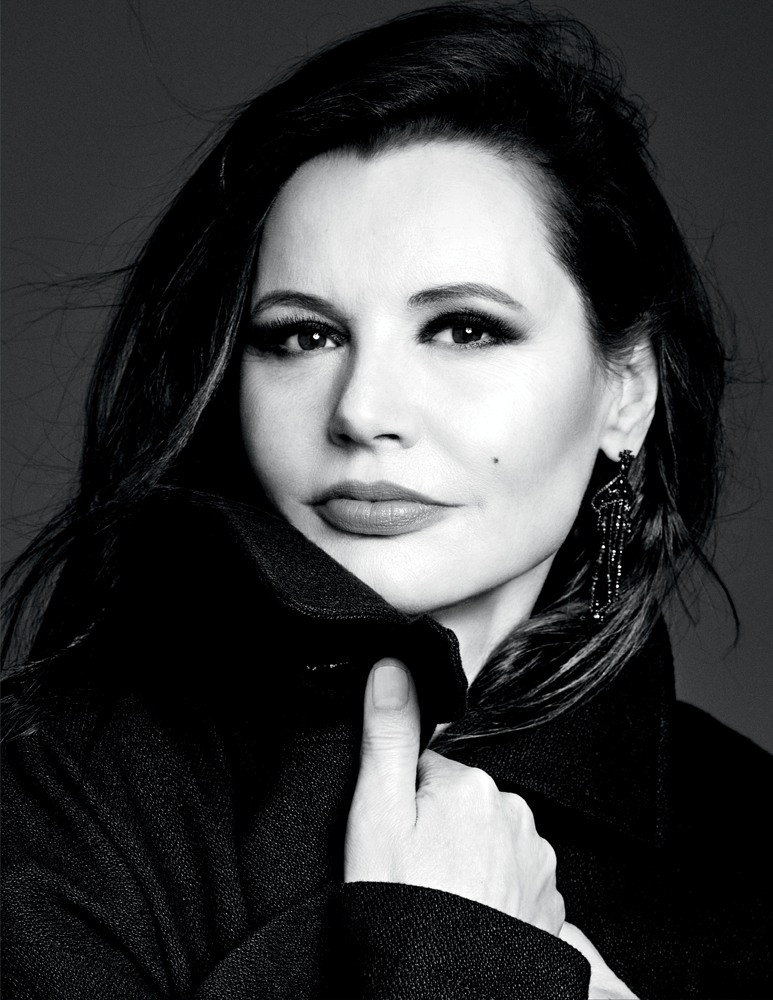Q&A: ‘If She Can See It, She Can Be It’

Despite the fact that women make up half the population and female-led movies have dominated the box office in recent years, women — and their voices — remain conspicuously underrepresented in film. Geena Davis, Academy Award winner and star of such classic female empowerment movies as “Thelma and Louise” and “A League of Their Own,” plans to change that — with a little help from artificial intelligence and a team of USC computer scientists.
In 2016, she launched the Geena Davis Inclusion Quotient (GD-IQ), which uses artificial intelligence to identify gender, speaking time and additional details about characters in the media. The software, designed by USC Viterbi Professor Shrikanth Narayanan, the Niki and Max Nikias Chair in Engineering, and his team at the Signal Analysis and Interpretation Laboratory (SAIL), caused ripples across Hollywood and beyond when its analysis found that in recent popular films, men had almost twice as much speaking time as women.
Since then, progress has been made: Last June, a GD-IQ analysis found on-screen gender parity had been achieved for the leading characters in the 50 most popular kids’ TV programs. In March, a new analysis found family films had as many women in lead roles as men for the first time.
Still, the battle is only beginning. Now the team is working with The Walt Disney Company and and Universal Pictures to “spellcheck” manuscripts and scripts for bias in gender, race, LGBTQIA, and disability, and with Google on achieving balanced gender representation in advertising. This year Davis, founder and chair of the Geena Davis Institute on Gender and Media at Mount Saint Mary’s University, will receive the Engineering Influencer Award at the 2020 Viterbi Awards for her work championing diversity in media.

Your mantra is: “If she can see it, she can be it.” Why is the issue of women in entertainment so important to you?
We judge our value to society by how we are reflected in the culture: “Oh, look, there’s someone like me — I must matter.” When my daughter, Alizeh, was just a toddler, I realized that children’s entertainment media was sending a message to kids that girls are not as valuable as boys, and this unconsciously sinks into both girls and boys. Media images are powerful. In the same way that a lack of positive images of girls can be damaging, showing female characters doing interesting and important things can inspire girls to do things they may not have realized they can do.
Tell us a bit about your work with the Geena Davis Institute. Why did you want to establish this institute?
When Alizeh was very young, I realized how few female characters there were in media made specifically for kids, which shocked me. Obviously, I also noticed how poorly many of them were portrayed. I didn’t intend to make it my life’s mission at first! But when I brought it up to creators in the industry, I couldn’t find one other person who noticed what I was seeing. They all assured me that gender imbalance in kids’ media had been “fixed.” That’s when I decided I needed the data: I could go directly to the creators and share it with them in a private, collaborative way, which has worked very well for us.
Let’s go back to your landmark study with our very own Professor Narayanan on uncovering gender bias in media. You found that women in Hollywood had significantly less screen time and speaking time than men. What was your first thought when you heard the results? Were you surprised, or was it something you suspected?
From what I had already learned, I did expect the results to reveal gender bias, but the imbalance in both TV and movies made for kids was more than I could have guessed. Not only are there far fewer female characters in media aimed specifically at young kids, but those that are there are seen and heard far less than the male characters.
What is the impact of women being underrepresented and misrepresented in film and television beyond the screen?
It limits what men and women think women are capable of, and it teaches us to believe that men are better at and more suited to do most things. Conversely, showing women on screen in various occupations encourages women to pursue those careers, and telegraphs to men that it’s natural for women to be doing those things. With so many female forensic scientists on TV, the percentage of women in that field has skyrocketed. It even has a name: the CSI Effect.
Very interesting! So is it only what we see that matters? Or is gender diversity behind the screen important as well? I was surprised to learn the silent film era was full of female movie directors.
It is equally important for the creators and storytellers to be gender balanced. With so few women’s voices being heard, we have become trained to see everything through the male gaze. Girls as young as 6 have now learned that their role is to be objectified.
Do you think things have changed since this study in 2016?
The area that has seen the most change is on screen in children’s TV shows: The percentage of lead characters who are female was 42 percent in 2008; that rose to 52 percent by 2018. We were beyond thrilled to see one of the most important goals we set — on-screen parity — had been reached during the time we’ve been advocating for it. Movies haven’t budged yet, but we’re very confident that on-screen representation will improve significantly within the next five years.
You have referred to data as the “magic key.” Why are numbers important for moving the needle?
The big advantage we have in moving the needle for kids’ on-screen representation is that the bias was unconscious. That meant that the data opened their eyes to something they absolutely could not see. Combine that with the fact that people in kids’ media want to do right by kids, and you’ve got a group that’s very eager to make the necessary change.
How did this partnership with USC come about?
In 2013, we received a $1.2 million Google Global Impact Award to help us create software to conduct our research. We explored potential resources [who] were experts in machine learning for audio and video. [Professor] Shri Narayanan at the USC Viterbi SAIL lab was at the very top of the list.
What was it like working with Shri and other USC computer scientists?
Shri and his team have a great sense of humor and are very nimble. When we met with them for the first time, we said to Shri and a room full of engineers that we wanted a “thingy” that could automate extracting gender along with screen and speaking time for moving images. Eventually, in 2016, this became GD-IQ, which has now gone well beyond just measuring gender. And now we’re collaborating on a new tool that builds off of our GD-IQ and USC’s patented text IP, which we call Spellcheck for Bias, which can analyze text in scripts, books and more. We’re already testing it with major studios like The Walt Disney Co., Universal Pictures and many others.
How do we change things in Hollywood quickly? What is the first change you would recommend?
Well, I can speak about the advice I give creators as to the quickest way to boost the female population in Hollywood: go through the projects you’re already working on and do a “gender pass.” Determine which characters could just as easily be female, and simply change their first name! It can be that simple. Without stopping to think about it, we all tend to make the default male. There are plenty of characters that could have a gender swap without changing the plot or triggering a big rewrite.
I know you have a daughter in her late teens. What do you hope for the next generation of women?
I can see that this is an amazing generation coming up, with very evolved ideas about women, people of color and LGBTQ+ individuals and empowerment. My daughter and her friends are fierce in their commitment to making change. I think we all have noticed this about our teens and young adults across America.
You will receive the “engineering influencer” award at the USC Viterbi Awards. What does this mean to you?
I’m thrilled and honored to be recognized in this way. I’ve so enjoyed this collaboration with Shri and his team. My dad was an engineer, and while I am not (my brother is), I get great satisfaction out of collaborating with engineers. I wish my dad were here. He’d be proud.
You said you were first introduced to the word “feminism” as a child through a Reader’s Digest article that claimed feminists were “ruining the world.” How would you rewrite that headline today?
“Unless you truly believe women are second-class citizens, you are a feminist.”



